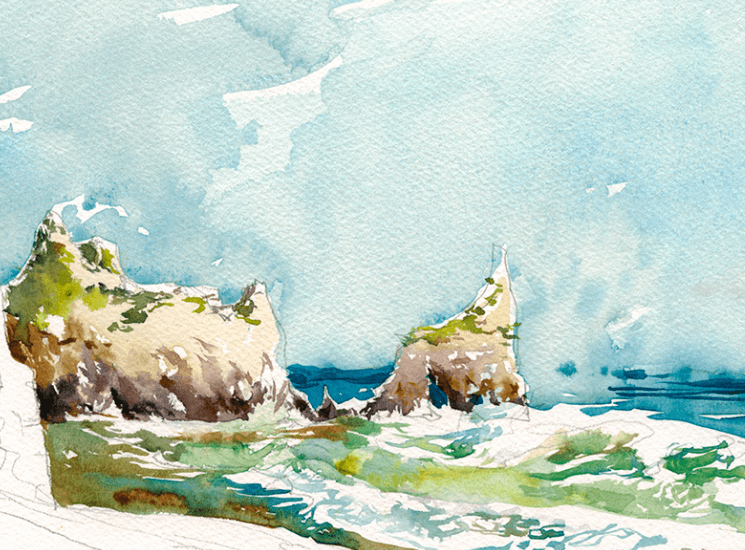Watercolor is a versatile and expressive medium that allows artists to create a wide range of effects, including the use of shadows and highlights to add depth and dimension to their paintings. Whether you’re a beginner or an experienced painter, learning how to work with shadows and highlights is essential for creating realistic and captivating watercolor art. In this article, we will explore the basic to expert techniques for working with shadows and highlights in watercolor painting, including tips and tricks to help you master this important aspect of watercolor art.

Understanding the Importance of Watercolor Shadows and Highlights
Shadows and highlights are crucial elements in watercolor painting that help to create the illusion of depth and dimension. By using these techniques effectively, artists can add visual interest and realism to their paintings, creating a sense of light and shadow that enhances the overall composition.
Reflection light
Another important aspect of painting shadows is understanding reflected light. The reflected light is the light that bounces off the surrounding surfaces and reflects onto the shadow. For instance, if you have a red apple casting a shadow on a white surface, the shadow will have a slight tint of red due to the reflected light bouncing off the red apple.
To paint reflected light, you’ll need to mix a small amount of the object’s color into the shadow color. This will create a more realistic shadow that accurately represents the reflected light.
Understanding Shadow Colors
The first step to painting shadows in watercolor is understanding shadow colors. Shadows are not just black or gray, but rather a darker version of the color they fall upon. For instance, if you have a green apple and it’s casting a shadow on a red surface, the shadow will be a darker shade of red. This is because the shadow is not just affected by the object casting it, but also by the surrounding colors.
Mixing Shadow Colors
To mix shadow colors, you will need to add a darker shade of the color it falls upon. For instance, if you have a yellow object casting a shadow on a blue surface, you’ll need to add a darker shade of blue to the yellow to create the shadow color. This will create a more realistic shadow that blends well with the surrounding colors.
Layering Shadows
To create depth and realism in your paintings, you’ll need to layer your shadows. Start with a light wash of your shadow color, and then gradually add more layers to increase the intensity of the shadow. This technique will create a more realistic shadow that appears to be casting from the object.
Basic Techniques
- Wet-on-wet technique: Wetting the paper before applying the paint can create soft and subtle shadows and highlights.
- Dry brush technique: Dry brushing allows you to create crisp and precise highlights by removing paint from the brush.
- Layering technique: By layering different colors, you can create depth and dimension, and build up shadows and highlights over time.
Advanced Techniques
- Glazing: Applying thin layers of color on top of each other can create a transparent effect that adds depth and luminosity to the painting.
- Wet-on-dry technique: Applying wet paint onto a dry surface allows for more control over the placement of shadows and highlights.
- Lifting technique: Removing paint with a damp brush or sponge can create highlights and subtle tonal changes.
Tips and Tricks for Creating Realistic Shadows and Highlights
- Observe the subject carefully: Pay attention to the light source and the way it interacts with the objects in the scene.
- Use complementary colors: Using the opposite color on the color wheel can help to create natural-looking shadows and highlights.
- Experiment with different brushes: Different types of brushes can create different effects, from soft and subtle to crisp and precise.
FAQs
Can you use white paint to create highlights in watercolor?
White paint is not typically used in watercolor painting, as the medium relies on the transparency of the colors to create luminosity and depth. Instead, artists use techniques such as dry brushing and lifting to create highlights.
How do you create shadows and highlights in a landscape painting?
Shadows and highlights are created by observing the way light interacts with objects in the landscape. By paying close attention to the light source and the way it falls on the trees, rocks, and other elements of the scene, artists can create realistic shadows and highlights using the techniques outlined in this article.
Conclusion
By mastering the art of painting shadows, you’ll be able to add depth, contrast, and realism to your watercolor paintings. Understanding shadow colors, mixing shadow colors, layering shadows, and painting reflected light are all crucial elements to creating realistic and stunning shadows. With these tips and techniques, you’ll be able to take your watercolor paintings to the next level.
